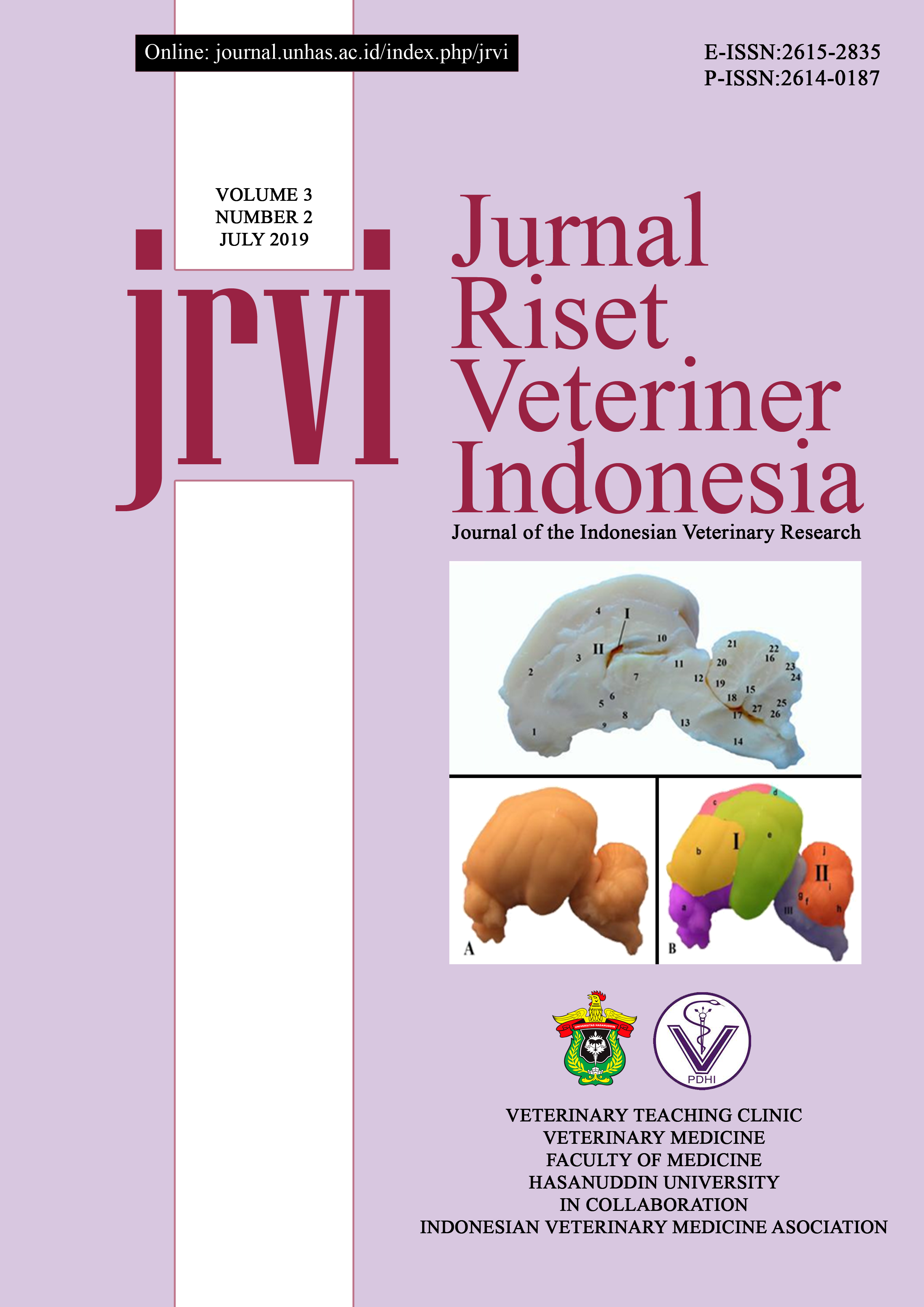Abstract
Trachypithecus auratus is one of the vulnerable primate species that is declining in number due to illegal hunting and forest degradation. The efforts to increase population can be through ex-situ conservation program that are specific to reproduction. To date, little is known about the reproduction of this species, particularly in the aspect of sexual behavior. The aim of this research was to analyze the sexual behavior of T. auratus at the Taman Safari Indonesia ex-situ conservation facility. This research conducted on five adult individuals from a group of consisting of one male and four females. The group of T. auratus were observed for five months from September 2018 until January 2019. The method used focal animal sampling with BORIS (Behavioral Observation Research Interactive Software). The results showed that the females performed pre-copulation (courtship) behavior such as head shaking (28.90%), hindquarter present (17.33%), raising a forelimb (11.66%), and the male performed pre-copulation (courtship) behavior such as genital inspection (68.46%). Copulation lasts for 60 seconds, starting with male mounting and thrusting as many as 40 seconds and ejaculation which is thought to occur for 20 seconds. At the end of the copulation sequence, a pair of T. auratus showed grooming and foraging together. The conclusion of this research was T. auratus has parameters of sexual behavior with copulation that lasts for 60 seconds and head shaking was sexual behavior that can be used as an signal for mating. This research are expected to be used as basic reproductive biology data to support the breeding and conservation program of T. auratus species.References
Altmann, J. 1974. “Observational Study of Behavior : Sampling Methods”. University of Chicago : USA.
Beach, FA. 1976. Sexual atractivity, proceptivity, and receptivity in female mammals. Hormon & Behav. 7: 105-138.
Bennett, EL., Davies AG. 1994. “The ecology of Asian colobines. Colobine monkeys: Their ecology, behaviour and evolution”. Cambridge: Cambridge University Press.
Bernstein, IS. 1968. The lutong of Kuala Selangor. Behaviour 32(1), 1-16.
Borries, C., Koenig, A., Winkler, P. 2001. Variation of life history traits and mating patterns in female langur monkeys (Semnopithecus entellus). Behavioral Ecology and Sociobiology, 50(5), 391-402.
Clay, Z., Pika, S., Gruber, T., Zuberbuhler, K. 2011. Female bonobos use copulation calls as social signals. Biol. Lett.
Dixson, AF. 1977. Observations on the displays, menstrual cycles and sexual behavior of the “Black ape” of Celebes (Macaca nigra). J. Zool. 182:63-84.
Dixson, AF. 2012. “Primate Sexuality: Comperative Studies of The Prosimian, Monkeys, Apes, and Humans”. Ed-2. UK : Oxford University Press.
Friard, O., Gamba, M. 2016. BORIS: a free, versatile open source event logging software for video/audio coding and live observations. Methods in Ecology and Evolution, 7(11), 1325-1330.
Furuya, Y. 1961. The social life of silvered leaf monkeys. Primates, 3(2), 41-60.
Harding, LE. 2010. Trachypithecus cristatus (Primates: Cercopithecidae). Mammalian Species, 42(862), 149-165.
Harley, D. 1990. Aging and reproductive performance in langur monkeys (Presbytis entellus). Am. J. Phys. Anthropol. 83(2), 253-261.
Iskandar, E., Kyes RC. 2016. “Tingkah laku monyet ekor panjang (Macaca fascicularis) di penangkaran”, in: Hewan Model Satwa Primata Volume I "Macaca fascicularis" Kajian Populasi, Tingkah Laku, Status Nutrien dan Nutrisi untuk Model Penyakit. Sajuthi D, Astuti DA, editor. Bogor (ID): Institut Pertanian Bogor Press.
Koenig, A., Borries, C., Chalise, MK., Winkler, P. 1997. Ecology, nutrition, and timing of reproductive events in an Asian primate, the Hanuman langur (Presbytis entellus). J. Zool. 243(2), 215-235.
Maestripieri, D., Roney, JR. 2004. Primate copulation calls and postcopulatory female choice. Behav. Ecol. doi: 10.1093/beheco/arh120.
Nelson, RJ. 2011. “An Introduction to Behavioral Endrocrinology”. Ed ke-4. USA : Sinauer Associates.
Newton, PN., Dunbar, RI. 1994. “Colobine monkey society. Colobine monkeys: Their ecology, behaviour and evolution”. Cambridge: Cambridge University Press. PP: 311-346.
Nikitopoulos, E., Arnhem, E., JARAM van, H., Sterck, HM. 2004. Influence of female copulation calls on male sexual behaviour in captive Macaca fascicularis. Int. J. Primatol. 25 (3): 659-677.
Rowell, TE. 1972. Female Reproduction cycles and social behavior in primates. Adv. Stud. Behav, 4:69-105.
Rudran, R. 1973. The reproductive cycles of two subspecies of purple-faced langurs (Presbytis senex) with relation to environmental factors. Folia Primatologica, 19(1), 41-60.
Saltzman, W., Tardif, SD., Rutherford, JN. 2010. Chapter 13 : Hormones and reproductive cycles in primates. Hormon & Reprod Verteb. 5:1-29.
Solanki, GS., Kumar, A., Sharma, BK. 2007. Reproductive strategies of Trachypithecus pileatus in Arunachal Pradesh, India. Int. J. Primatol. 28 (5),
Stanford, CB. 1991. “The capped langur in Bangladesh: behavioral ecology and reproductive tactics (Vol. 26)”. Karger Medical and Scientific Publishers.
Supriatna, J., Manullang, BO., Soekara, E. 1986. Group composition, home range, and diet of the maroon leaf monkey (Presbytis rubicunda) at Tanjung Puting Reserve, Central Kalimantan, Indonesia. J. Primatol, 27(2): 185-190.
Wright, PC., Toyama, LM., Simons, EL. 1986b. Courtship and Copulation in Tarsius bancanus. Folia Primatol, 46:142-148.
Yeager, CP., Kool, K. 2000. “The Behavioral Ecology of Asian Colobines”. In: Old World Monkeys. Edited by Whitehead PF, Jolly CJ, Cambridge: Cambridge University Press.

